Poker Face (13 page)
Authors: Maureen Callahan

A source said: “She kicked up a stink and demanded someone get her cup and saucer back.
“She wouldn’t drink out of anything else. It just looked like any other cup and saucer to me and said ‘Made in China’ on the bottom. It seemed a lot of fuss over nothing.”
A spokesman for Lady Gaga said: “Lady Gaga does not want to reveal anything about the teacup itself, but drinking ginger tea is very good for singers.”
Saint, who wound up hanging with Gaga that night almost accidentally—he was so excited to receive a last-minute invitation from her to hang out that he pushed his departing flight back till the next morning—says the night was all “lychee martinis and great food. And she paid the bill. I haven’t seen or spoken to her since.”
Lady Gaga was still struggling to achieve anything near that level of recognition in the States. In March she was scheduled to appear on the morning talk show
The View,
which was broadcasting live from Disneyland. She had to be on location by five
A.M.
for the eight
a.m.
broadcast to the East Coast, where the show would air live at eleven
a.m.
A few days before, journalist Jonah Weiner had interviewed her in L.A. She’d just come from an appearance at KIIS FM in Burbank, where Weiner had watched her perform live in the studio.
“We were supposed to meet in her apartment in Koreatown,” Weiner says. He’d Google-mapped the address and discovered it was in a very generic, middle-class neighborhood, “tract houses and minivans,” he says. Then her publicist switched the location to a concrete park for corporate-worker lunch breaks.
When they met, Gaga was wearing white latex pants, a lavender leather blazer with gloves sewn on the sleeves, and sunglasses shaped like a trapezoid. She told Weiner, “I kind of realized I didn’t want you to see where I live.” He suspected that she hadn’t had much in the way of media training, which is basically an intense course in how to deal with interviews and publicity, to have a politic answer and talking points always at the ready, to deflect and defend.
“It seemed like she was trying to figure out, on the fly, the face she was going to put forward, how much of herself she was willing to give,” he says. “This was her first major interview. It’s that situation where you find your intimate complexity sublimated in a three-thousand-word article.”
At the same time, Weiner says, Gaga seemed one pace ahead of him. When he tried to order a bottle of wine for the table, she declined, saying she was in rehearsal, but insisted that the waiter keep refilling his wineglass and telling him she knew how it worked, that journalists always try to get their subjects drunk, but that she’d be getting him drunk instead. “She was cultivating this disarming coquettishness, but always in big quotation marks,” he says, “like a commentary on interviewee strategies and the journalist’s interviewing tropes.”
She flirted, but in such a way, he says, that she was almost acknowledging that the dual seductions in every interview resemble nothing so much as espionage-level attempts to extract information.
“She spoke in this feigned, almost little-girl voice, minding her p’s and q’s,” Weiner says. “Which is a very useful juxtaposition when you have lyrics as raunchy as ‘Poker Face.’ ” She was equally contradictory in conversation, seeming both transparent and tentative. When asked a question she didn’t want to answer—and those mainly had to do with sex—she’d say, “I don’t want to tell you that,” or “That’s nobody’s business but my own.”
The next day she appeared on
The View,
and her demeanor was markedly different from the arch hauteur she’d adopted for the UK: Here, she was the all-American girl who’d “hustled” from the time she was fourteen, who was just “so grateful,” who would simply “say my prayers every night,” and whose burgeoning success was “so exciting!” She was in an ash white bob with purple streaks and a white Judy Jetson–style minidress. “I am loving the panties,” said cohost Sherri Shepherd. Gaga then performed “Just Dance” to a small crowd of boxy Midwesterners who bounced along awkwardly.
Weiner was at the taping and found himself summoned to her trailer by a functionary. “Someone came up to me and said, ‘You are
soooo
lucky.’ I said, ‘Why?’ She said, ‘Gaga wants to show you something she’s never shown anyone before.’ ” When he walked in, she was getting her makeup done, bangs off her face. She excitedly showed him a picture of a new piece for the stage that she was working on: a Lucite piano filled with clear bubbles.
“She said, ‘Isn’t that cool?’ And I said, ‘Yeah.’ And I was dismissed.”
The bubble-filled piano was a companion piece to the bubble dress she debuted on the opening night of her Fame Ball tour on March 12; she also wore it on the cover of
Rolling Stone
’s “Hot Issue” that May. It was a direct rip-off of a dress made by Hussein Chalayan for his spring 2007 collection—something she did not mention. In February 2010, when she debuted what she called “the living dress”—a long, architectural white gown, replete with a vertiginous headdress and expansive gossamer, fairy-godmother wings, that contracts and expands on its own—she did not repeat the mistake. In a tweet before the dress was unveiled at her show in Liverpool, she wrote, “2nite Haus of Gaga debuts ‘the living dress’ inspired by Hussein Chalayan, as a fashion moment to be performed in a ‘pop show’ at Monsterball.”
Gaga’s biggest break yet in America came in April, when she was booked to perform on the results show for
American Idol.
She actually pretaped her appearance, doing three different versions, and the setups and technical issues between takes took so long that, after the second performance, the crowd was told they could leave if they wanted; half of them did. An EW.com reporter who’d been at the taping described the audience’s response to Gaga’s first performance, which paired “Bad Romance” with the far inferior “Alejandro” and involved an enormous water fountain, pyro, dry ice, Gaga in a lace bodysuit over a bra and thong, and tango-ing male dancers:
“. . . The audience was left so silently agog by the spectacle that afterwards . . . the PAs had to remind everyone that they were on camera, too, and should, you know, appear excited to be there.”
May was a huge month. Gaga played her now-famous show at Terminal 5 in New York City, drawing Madonna and her daughter Lourdes, and suddenly commanding the attention of the industry. She played four more shows, one in Austin, Texas, and the rest in California, including a set at an annual lesbian gathering known as the “Dinah Shore Weekend” in Palm Springs.
“She wasn’t a gigantic star when I approached her,” says Mariah Hanson, who owns the venue known as Club Skirts, which presents the Dinah. But by the time Gaga performed at the event, “Poker Face” was climbing the charts, so Hanson was even more impressed when she saw how Gaga threw herself into it, “250 percent.”
“She gave the audience—which was packed with gay men, which we don’t usually get—so much love and appreciation.” Also: She brought the bubble dress! “She joked around with her bisexuality, with the reasons behind writing the songs, and the audience just ate it up and became more effusive, and it just kind of fed on itself.”
Hanson books lots of acts on the rise, and has often been underwhelmed: “For instance, we had Ke$ha this year,” she says. “She doesn’t have a great show. It’s not like she won’t eventually, but Lady Gaga was somehow born for this. She understands the importance of merging art and marketing. When we think of Lady Gaga, we think of Cher or Madonna, and she’s been on our radar screens for less than a year.”
On May 28, her epic video for “Paparazzi,” directed by the gifted, idiosyncratic Jonas Åkerlund (Madonna, U2, the Smashing Pumpkins), was leaked. Or so she said on Twitter: “Stop leaking my motherfucking videos,” she wrote. The controversy, of course, just generated more interest in the clip, a seven-minute-plus-long narrative in which Gaga plays a star who is thrown off a balcony by her boyfriend (played by
True Blood
star Alexander Skarsgård, who generated even more controversy with his alleged comments about his displeasure in having to kiss her). She’s seen in a wheelchair, a neck brace, dancing, and making out with hair-metal boys on a couch, and then, finally, she kills her boyfriend.
She got a typically effusive assist from Perez Hilton, who posted it to his site with a review: “The new Princess of Pop, Lady Gaga, has created a masterpiece!” he wrote. “It is her strongest work to date. It is a mini-film. It is art. It is visual pornography. It is satire. It is commentary. It is brilliant!
And, we are NOT exaggerating
.”
It was her most sophisticated effort yet, a throwback to the lengthy, plot-driven mini-movies that acts like Michael Jackson, Madonna, and Guns ’N Roses produced in the eighties and nineties. Among the pop-culture references: Alfred Hitchcock’s
Vertigo,
the hair-metal band Warrant, and Minnie Mouse, whom Gaga was dressed like in the murder scene. Her high styling was due to Åkerlund’s wife, B. She built, among other things, the video’s infamous tricked-out wheelchair. Gaga hired her.
“They hit it off, but she didn’t last very long,” says a source. Gaga mainly relied on Matt Williams. David and Angela Ciemny describe Gaga and Williams as “like two peas in a pod,” both interpersonally and creatively. (The other key member of her team, and the only one whose tenure is as long, is her choreographer Laurie Ann Gibson, whose most high-profile gig prior was working on P. Diddy’s MTV show
Making the Band
.)
“Matt’s not the most social person, but he’s incredibly creative,” says Angela Ciemny. “He’s really passionate about vintage design in all aspects—technology, clothing, all that stuff.” They research together, she says, sourcing rare design books and old biographies, then sketching out modernized adaptations, tweaking elements, working out logistics. Though she says “Gaga shared a lot with me about all the people in her life, and he’s somebody that she really cares about,” Angela admits that she knows absolutely nothing about Williams.
As with David Ciemny, Williams and Gaga were introduced by someone on Troy Carter’s management team, and that individual will say nothing else. People who knew Williams in New York and worked with him in L.A. say they know almost nothing about him. He’s from California. He wanted to work in fashion. He may or may not have interned at the design house Proenza Schouler. He rarely spoke. He disappeared one day and popped up in L.A., and began seriously dating Erin Hirsh, the stylist who worked for Kanye West. Hirsh had been approached by Lady Gaga to come work for her, but Hirsh had no interest. She recommended Matt Williams, who then dumped Hirsh and began dating Gaga. Williams told Gaga that Kanye was a fan, loved her style, and she’d get paranoid, warning Williams: “Don’t tell Kanye what I’m doing!”
The one thing everyone does recall about Williams: He seemed to be an opportunist, and not a very subtle one.
“He really was handsome beyond belief,” says one source who socialized with Williams in downtown New York in 2007, and who says that Williams was intent on breaking into his social circle, which included actors and designers and was led by Proenza Schouler’s Jack McCollough.
According to one source, McCollough wanted nothing to do with Williams. He then wound up spending a lot of time with fashion designer Ben Cho, who was young, gifted, popular—the locus of the Lower East Side social scene. Cho was friends with downtown influencers in every subculture, connecting skate rats to starlets, starlets to photographers, photographers to artists and designers and musicians. He hung out with actresses Chloë Sevigny, Christina Ricci, and Natasha Lyonne; photographer Ryan McGinley and the late artist Dash Snow; singer-songwriter Chan Marshall (aka Cat Power). He’d give his friends tattoos, host them at his weekly Sunday-night Smiths-tribute party at a club called Sway. If you wanted to be in with the downtown art-scene A-list, Cho was the key.
“From the minute we met Matt, we did not trust him,” says a friend of Cho’s. “Ben was in love with Matt, and Matt hung out with Ben 24/7. We just thought there was something very untrustworthy and shady about him. Everyone thought he was a social climber.”
“He was always so calculating,” says another source. “I remember one night having dinner in the West Village with Matt and Ben. Ben was really enchanted with Matt, but it was, like, Matt was straight, of course. But he would always be sitting there [being] cute, and then he started talking and he was just kind of eager. . . . I don’t remember it being Oscar Wilde in the garden, you know?”
“I remember Matt as young, eager,” says another acquaintance from this time. “He was super fashion-y. He hung out with Ben forever and with [rising] photographer David Sherry. He definitely wanted to be connected to [the right] people, but I actually got a really good impression of him.”
This source, along with Brendan Sullivan, recalls Williams’s scene as mainly gay men who worked in fashion. When it came to men who were interested, this source says “he really wouldn’t go there. He’d bring it close to that—sleepovers, shit like that—but nothing weird.” One friend of Ben Cho’s remembers Cho introducing Williams around as his boyfriend, and another isn’t sure exactly what went on in that relationship. But Cho’s friend says she believes Williams and Cho were a couple, and that Williams didn’t care who he hurt, had no problem using people and tossing them aside when he was done.
Both sources say Cho was devastated when Williams suddenly picked up and left for California. No one knew why he was leaving or what he planned to do there, and then, months later, they heard he was working for Lady Gaga.
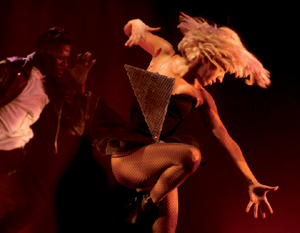
A knockout performance in a knockout dress at the Wiltern in L.A., March 2009.
Michael Buckner/Getty Images
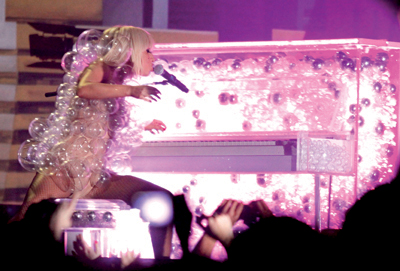
Performing in her beloved bubble dress at her even more beloved bubble-filled piano at Philadelphia’s Electric Factory, May 2009.
Scott Weiner/Retna Ltd.
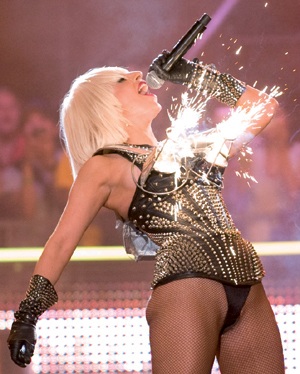
A Rubicon has been crossed: Gaga’s bra explodes at the 2009 MuchMusic Video Awards in Canada.
© The Toronto Star/ZUMA Press
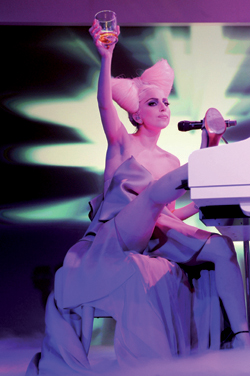
The bow made of hair accents the architecture of the dress, and the eye makeup keys off the color palette: Lady Gaga toasts the crowd at Skylight Studios, NYC, December 2008.
Theo Wargo/Getty Images for VEVO
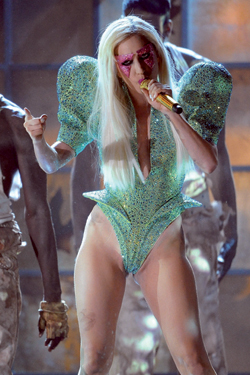
Distinctly referencing another influence, androgynous shock-rock star Marilyn Manson, at the 52nd Annual Grammy Awards in L.A., January 2010.
Michael Caulfield/WireImage
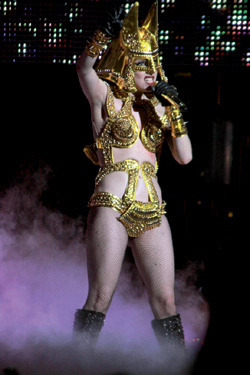
Like a cross between a Roman bathhouse warrior and Tina Turner in
Mad Max: Beyond Thunderdome
: Gaga onstage at New York’s Radio City Music Hall, January 2010.
Sonia Moskowitz/Globe Photos
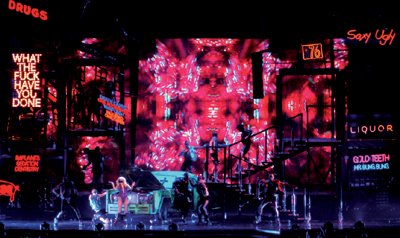
Gaga at the opening of the European leg of her “Monster Ball” in Odyssey Arena, Dublin, 2010.
WENN
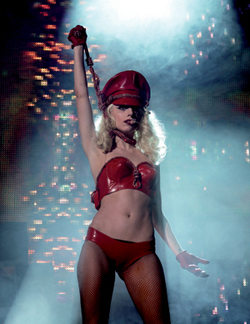
As a vaguely suicidal red-leather dominatrix with impressive abs: Gaga performing at Capital FM’s Jingle Ball in London, 2009.
Yui Mok/PA Wire/Press Association Images
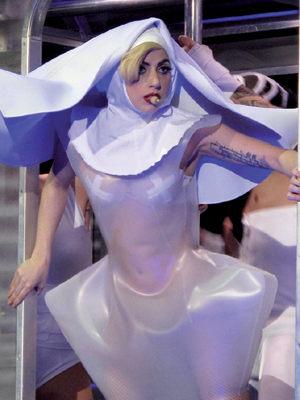
Part Sally Field as “The Flying Nun,” part Madonna
in her Church-baiting days: fishnets, nipple bandages, and a see-through habit make the standby nun costume thoroughly Gaga.
Splash News
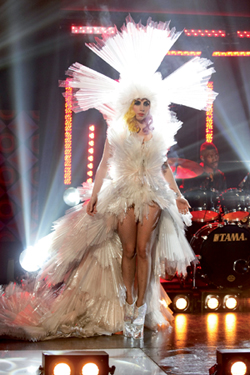
In the stunning, ethereal “mechanical dress” that folded out and opened on its own, on Britain’s
Friday Night with Jonathan Ross,
March 2010.
Brian J. Ritchie/Hotsauce/Rex/Rex USA
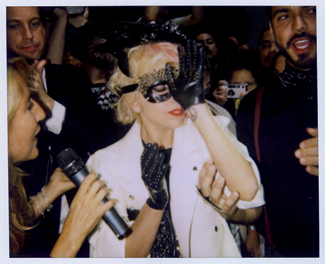
In full-on beleaguered star mode at the Marc Jacobs Spring 2010 show, New York City, September 2009.
Jeremy Kost/WireImage
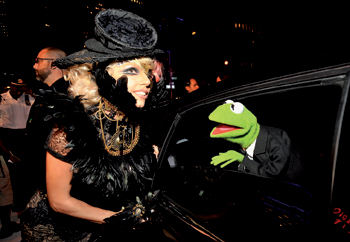
With fellow misfit Kermit the Frog at the MTV Video Music Awards at Radio City Music Hall, 2009.
Kevin Mazur/WireImage
